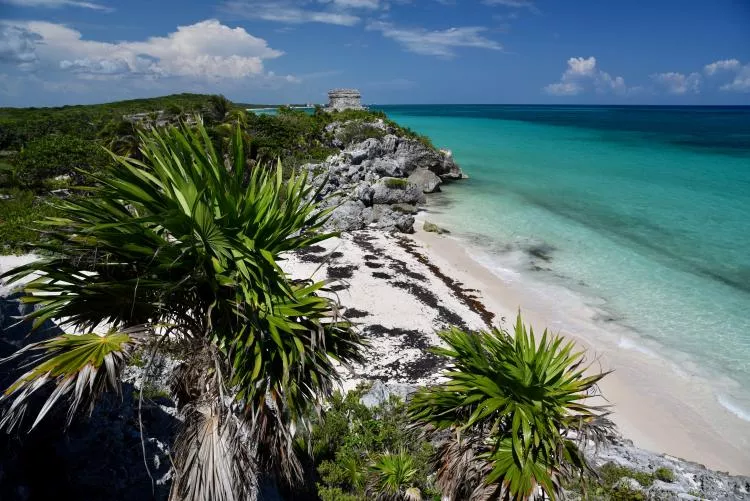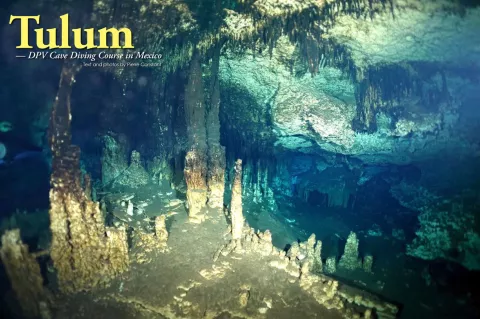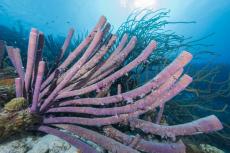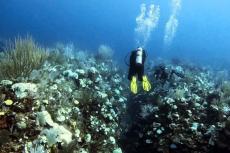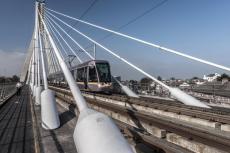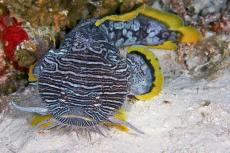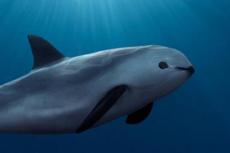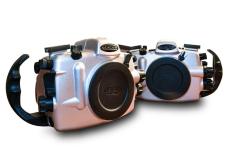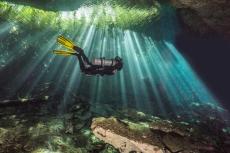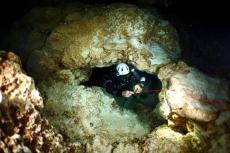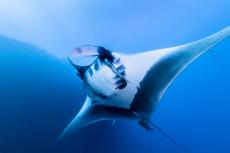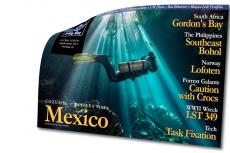Tulum has changed a lot since I was here last, well over 45 years ago. Once a mere dusty village with beach huts, it is now a booming town with a main street full of bars, restaurants and tourist shops.
Contributed by
Turning the wheel to the right at a crossroad, I heard a loudspeaker blaring a warning message straight out of a science fiction movie: “Precaución, you are entering a highly dangerous zone…” It clearly mentioned the alert level of Covid-19. I soon found ProTec Dive Center and The Basecamp hotel near the end of Avenida Satélite. “Oh, we have had this scary recorded message for months now. Nobody pays attention anymore. It’s pathetic!” exclaimed Kim Davidsson, the director of customer experience.
After quickly settling my belongings in one of the rooms upstairs, I ran downstairs again in no time. My Diver Propulsion Vehicle (DPV) Cave Diving course was to start right away in one of the small classrooms. Kim, who is a Swedish TDI instructor, has been a resident here for over 20 years. “You’ll be the only one today. Tamita couldn’t make it this time.”
Starting with mutual introductions, Kim went into the theory of DPVs, the equipment and a workshop where I had a close look at the Polish-made Seacraft DPV, an elongated, round-nose, rocket-type of machine, with a propeller inside a metal ring, two handles as expected on a scooter, and an electronic dashboard with lights and numbers—a rather impressive piece of equipment for a neophyte like me. “A sophisticated toy worth no less than US$8,000 to $9,000,” concluded Kim. I was definitely eager to know how it worked and to understand the concept of a “tow-behind” scooter.
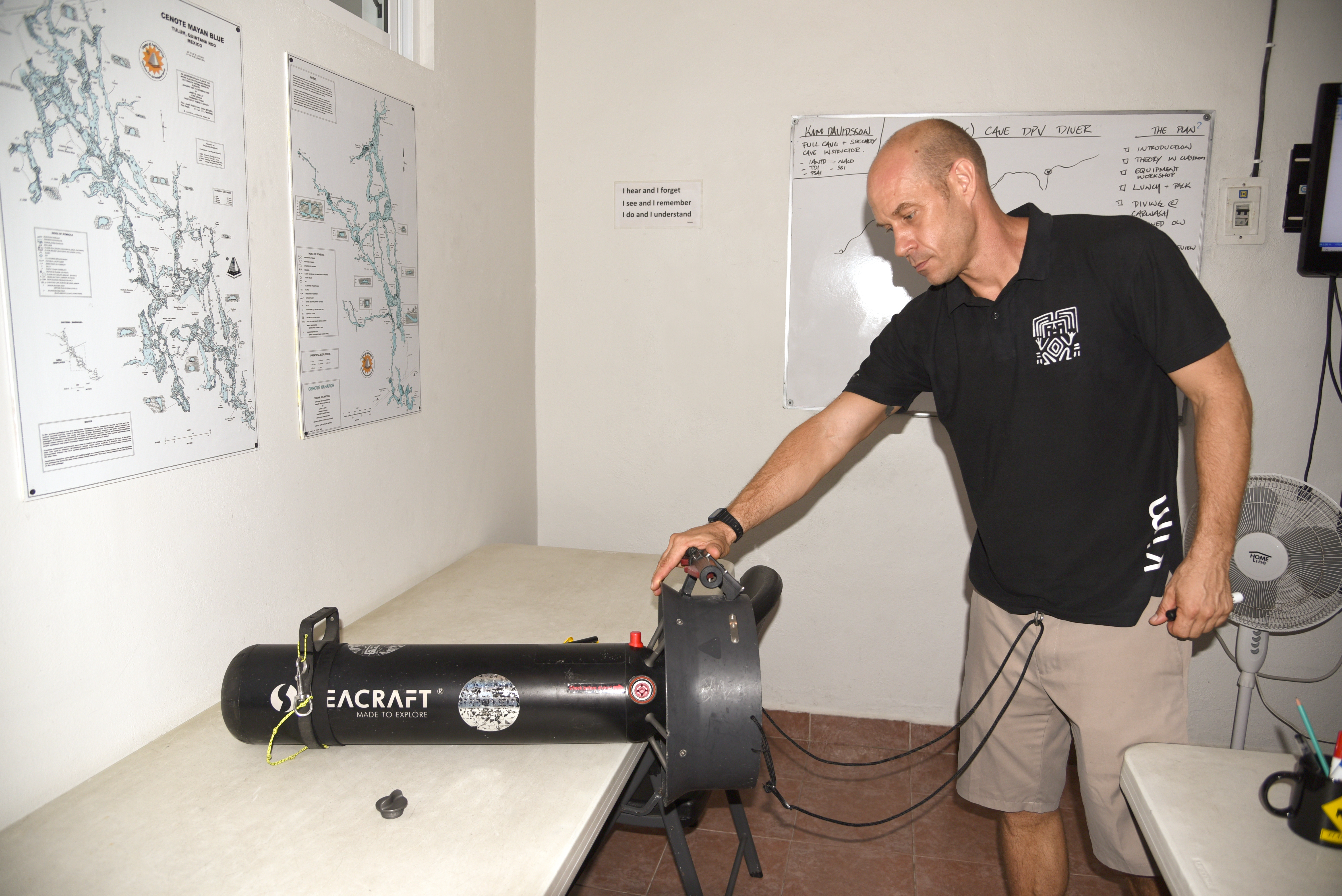
About the DPV
Basically, the DPV is electronically charged by a powerful battery, with up to four hours of runtime. When you turn the switch on, the screen lights up, and you can see the percentage of the battery charge in the lower right corner. The two little buttons, placed one above the other on the dashboard, are the gears for moving upwards and downwards when pressed.
In the lower-left corner of the screen, you can see the Speed Indicator, which goes from 1 to 9, and even to the “R” position, which stands for “Reverse.” Next to it, you have the “Runtime.” An average speed would be 4 to 5, fast is 6 to 7, and 9 is crazy fast—there are 10 speeds altogether, including the speed in reverse.
The trigger is found on the handles of the DPV, on both the left and right sides. “And that little piece of loop bungee here is for the cruise control, and it will maintain the chosen speed at all times,” he smiled. I began to feel the thrill of it all. This was either good or bad, depending on one’s mood and mental state. Crikey!

Cenote Carwash
After a picnic on the way there, we were off to Cenote Carwash. Once underwater, I could not manage to hold the DPV steady. As soon as I pressed the trigger, it pointed its nose up each and every time, like a bucking horse. Overwhelmed with a feeling of frustration, I realised it was not as easy as I had thought.
After a while of desperately trying to stabilise the machine, with no improvement whatsoever, the instructor’s annoyance was palpable. Suddenly, as we surfaced, he made it clear that it was not too late to give up on the course. In short, he suggested that I could quit if I chose to. Surprised, I took it as an insult.
“You should be neutrally buoyant!” advised Kim. In short, if the scooter pointed up, you were negatively buoyant; if it pointed down, you were positively buoyant. “Do not manhandle the DPV, let it pull you!” he said. “Always remember: Buoyancy, trim, position, action.”
Eventually, I made the necessary corrections, and it worked better. Different skills were practised, like changing hands when holding the scooter, deflating, and clipping a dive torch on and off the D-ring on the back of the unit. We drove around the pond a few times at speed 4, turning, changing directions sharply, changing speed, stopping abruptly, and pulling the DPV backwards to hold it by the front handle. After an hour and a half in the water, I started to feel a bit cold.
Then it was back to ProTec’s office in Tulum for a compulsory debriefing. Kim showed me the GoPro videos of my evolution underwater. It turned out that a number of necessary adjustments were needed on my gear and harness.
The waist D-ring should be moved farther back, roughly above the hip bone. I should have separate bungee cords to hold the valves of the sidemount tanks, instead of one continuous bungee running from one side to the other side along the shoulder blades. Finally, the tank rings holding the clips should be moved farther up.
The revised configuration would first allow for a better trim of the tanks along the sides. Secondly, the tank valves would come below the armpits to facilitate greater ease of movement for the arms in front of the body. I suddenly grasped the advantages of all these key adjustments. At the end of the day, a customised configuration is of the utmost importance.

Day Two
The theory part of the course took place in the classroom, starting with the history of DPVs, followed by a lecture on gas consumption. The travelling distance with a DPV is affected by breathing and therefore implies the need for gas management. The fact is that swim time is three times greater than DPV time. Back in 1984, the Tekna DPV had a runtime of 60 minutes. Nowadays, the Seacraft can run for four hours.
Realistically speaking, what is the point of penetrating so far into a cave, if you cannot come back—either because you run out of air, or if the DPV fails for some obscure reason? The awareness struck me between the eyes. Could I make it back from the far end of a cave? If the DPV fails, I would need three times as much time to return by swimming.
Planning accordingly leaves no other option. It means, for example, that 35 bars on the trigger is equal to a 105-bar swim. Should you use half of your stage tank for penetration before dropping it, you should only use a quarter of your sidemount tanks afterwards. Alternatively, using a third of your stage tank means using a third of your side tanks afterwards. It is therefore necessary to consider the total amount of gas and divide it by three for penetration.
Cenote Cristal
That afternoon, we went out to dive Cenote Cristal. A Mayan family with kids was having some fun playing in the water there. With all our equipment, we looked like aliens from outer space. Laying down the tanks and the gear on the wooden steps, we took up a lot of space. The kids moved shyly to the sides, staring with curiosity.
I had to practise the drop and retrieval of the DPV on the guide line. The tow cord had to be clipped first, followed by the nose clip of the DPV, with a double twist. We entered and moved through the cavern for a while, laid the DPV on the line, retrieved it and exited. Eventually, Kim left me to drive the scooter alone around the cenote, for comfort, while he reeled back the line. Another hour-and-a-half session in the water, I fared better today with buoyancy control and the effortless pull of the DPV.
At a local fruit stall in town, next to a small park, Kim treated me to an agua de maracuya (passionfruit water). A big orange signboard read: “Obligatorio uso de cubre boca – Mantenga su distancia – Sandwich de jamon y queso M$20” (Face mask compulsory – Keep your distance – Cheese and ham sandwich 20 pesos).
Kim showed me the video of my new trim on his cellphone, with the position of the tank valves under my armpits, and the tanks aligned to my body. I was filled with contentment, as Tulum’s city lights glowed along Satelite Avenue, and a peaceful seafood dinner at Mil Amores restaurant with a cerveza Modelo Especial (beer) sealed the evening.
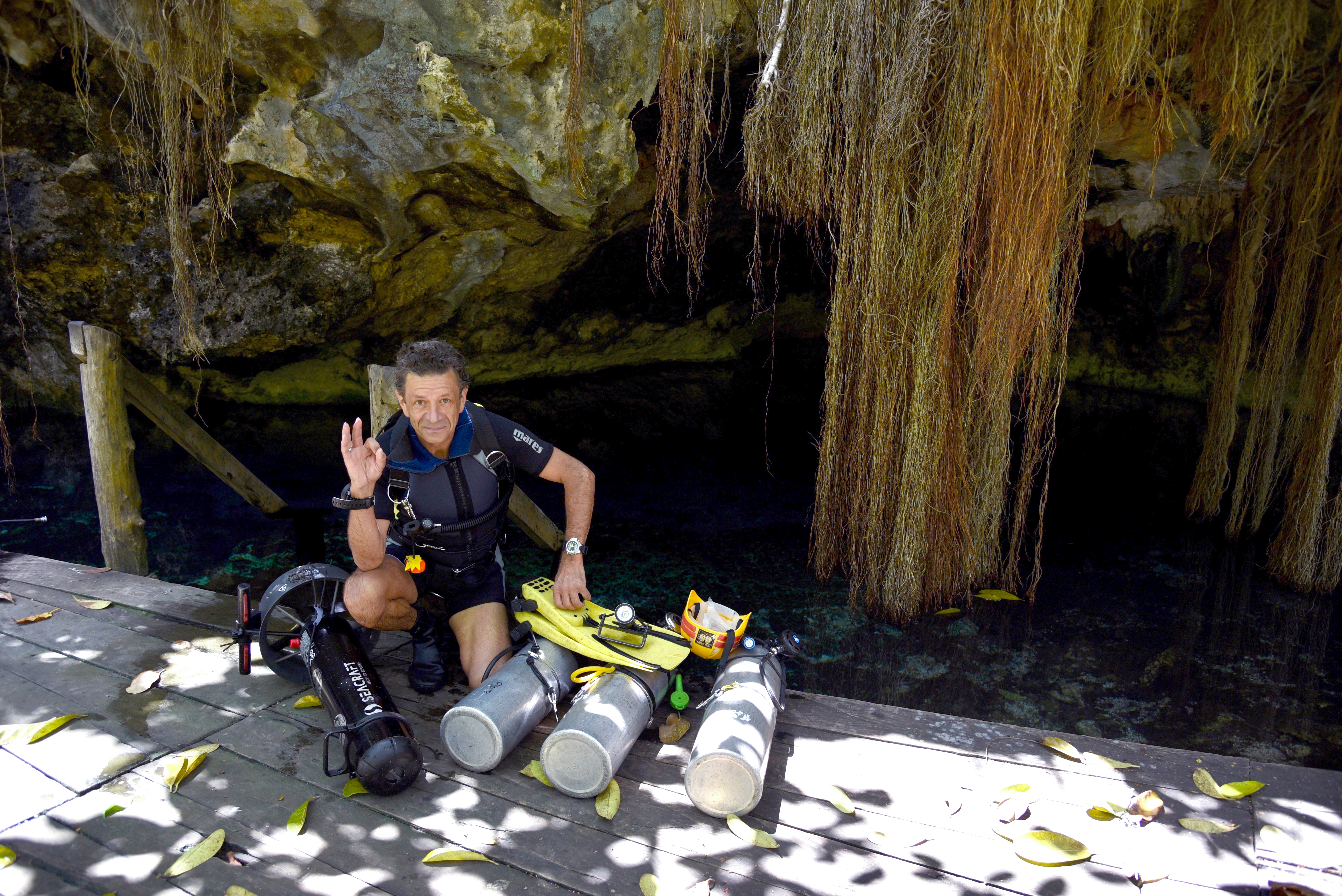
Cenote Nohoch Nah Chich
The next day, the classroom session was short. The theme we focussed on today was surface air consumption. The chosen site for diving was Cenote Nohoch Nah Chich, a beautiful cave with a long ornate tunnel.
Different case scenarios would be studied and analysed. First, we did a swim with a sidemount configuration over a distance of 15 minutes in and 15 minutes out, leaving a cookie on the guide line for reference. The same distance in and out was covered while breathing from the stage. The operation was repeated again, this time with DPV speed 4—still breathing from the stage. Finally, the procedure was repeated once more with DPV speed 6. All the above took place at an average depth of 4.1m, which remained constant.
The reasoning behind it all was to calculate the time taken for the same distance, and for each exercise, the gas consumption at the beginning and at the end, and the number of bars converted to litres. In the end, the purpose was to calculate the surface air consumption (SAC), when the number of litres used was divided by the time, and then by the depth in atm.
The instructor brought his slab underwater in order to write down all the data precisely. I performed the return swim in 30 minutes, and the same stretch at DPV speed 4 in 12 minutes 30 seconds, and at DPV speed 6 in nine minutes. At that speed, I felt like I was flying, and the stage hose over my shoulder was shaking like a leaf in the wind. Kim placed it under my armpit. Problem solved. Negotiating curves to the right or to the left was under control now, even the sharp ones.
In the next skill exercise, I was to pretend that my scooter had suffered a failure. Then, Kim would tow me, with the front of my DPV clipped to the back D-ring of his harness. During the procedure, I remained streamlined, slightly above and behind him to avoid the “prop wash,” shining the way forward with a dive light attached to the back of my hand. Although he drove the DPV at speed 6, it felt like we were going at speed 4. In fact, we took the same amount of time to cover the distance as when I made the trek at speed 4.
Now, it was my turn to tow Kim. My concentration and performance were optimum. Kim shook hands with me, proving me right. Eventually, I dropped the DPV on the guide line, then the stage, and retrieved them before exiting. I was elated with renewed confidence.

Last day
The last day of the course would take place at Cenote Escondido, also called Mayan Blue, located across from Cenote Cristal on the way to Coba. It was an elongated lagoon in lush vegetation. The plan was to scooter 90 bars into the main tunnel and 90 bars out.
At the end of the lagoon, at the cave entrance, there was a narrow vertical cleft, down to a depth of 20m. Here, we soon hit the halocline, and Kim zoomed ahead at speed 6. Riding in his wake, I hardly saw anything, except for a blurry halo of light in the distance, because of the huge disturbance caused by the halocline. Zigzagging left and right, and up and down—it felt like I was on a plane lost in the fog. I wondered how I did not bump into the walls or curves along the tunnel. It was a crazy, uncomfortable sensation. Kim did not seem to worry about me, banking sideways once in a while to check if I was still behind him. “Riding a DPV is the greatest challenge and highest level in cave diving,” he confided to me later.
Checking the depth on my dive computer, I realised with amazement that we were cruising at 24m. Reaching a double red arrow on the guide line, Kim placed a white arrow behind it, with a jump to the right. We entered a small tunnel with very nice chambers. There were 130 bars left when we reached a second jump. I waved my dive torch to signal the turnaround.
Leading the dive now, I did not suffer any side effects from the halocline—that was left for Kim this time! I did, however, notice a slight blurry line, just above eye level, as I slowly moved upwards. Back below the cave entrance, the DPV and stage were dropped on the line. When retrieving them again, I messed up a bit with the stage, swirling around and stirring up the bottom as I tried to clip it to the rear D-ring of the harness.
“This is unacceptable!” thundered Kim, when we were back at the car. A correction was made to my sequence with the stage, in four clear steps. Afterwards, I came back to the lagoon like a miserable-looking dog, with its tail between its legs.
I was already in the water for the second dive, with the tanks clipped in, when the O-ring of my regulator’s swivel suddenly sprung a leak. Bummer! In record time, Kim was out of the water, running back to the pick-up, and returned with a spare O-ring and the necessary tool to install it. I was impressed with this very efficient professionalism.
The plan was now to dive Mayan Blue’s tunnel B, up until the two red arrows on the guide line, and then turn around to reach a single white arrow marking a jump. In the cenote, Kim placed his spool line on the arrow, after we dropped the DPV and the stage. We proceeded on sidemount into a flat narrow winding tunnel with a low ceiling, purposely named “Death Arrow Passage.” The depth was 22m, and soon, we penetrated a breathtaking chamber with pillars and stalagmites, which we passed through until we reached another jump. With 140 bars left in the side tanks, I signalled the turnaround.
Leading the way back to where we left the stage, I picked it up, paying attention to my buoyancy in a decent manner, collected the DPV and scootered back to the lower cave entrance without incident. Rising up inside the terminal chimney, Kim pointed to my dive computer, which indicated an unexpected 15-minute decompression stop! A maximum depth of 26m was recorded for a dive time of 54 minutes. After Kim showed me speed 9 with his fingers, I finished the last five minutes of decompression time in the lagoon, doing loops at a hair-raising speed—“crazy fast” for sure, but I managed satisfactorily. Afterwards, the instructor shook my hand heartily. I did well—a happy note after a tense day.
Afterthoughts
As thrilling as the DPV Cave Diving course may be, it teaches you one thing worth considering: You are playing with the far side of your life, mate. Don’t you forget it. ■
With a background in biology and geology, French author, cave diver, naturalist guide and tour operator Pierre Constant is a widely published photojournalist and underwater photographer. Please visit: calaolifestyle.com.

